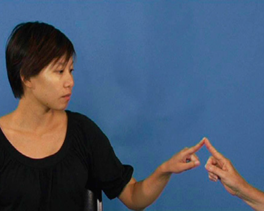AIM:
To assess motor impairments in ataxia
Rationale:
Assessment of ataxia includes:
- Finger-nose test
- Finger-finger test
- Rapid alternating movement test
- Rebound test
- Heel-shin test
- Rhomberg’s test
Equipment:
- 2 chairs
- Plinth or bed
- Pillow
Key points:
Finger-nose, finger-finger, rapid alternating movement and rebound tests:
- Ensure that the patient’s feet are supported on the floor
Finger-nose, finger-finger, and heel-shin tests:
- Note spatial and temporal accuracy, dyssynergia and intention tremor
- If the patient moves slowly during the tests, instruct the patient to go faster and observe any decrement in accuracy
Rebound test:
- Therapist provides resistance to isometric elbow flexion, then removes resistance
- Ensure that the therapist positions one arm to protect the patient’s face when resistance to isometric elbow flexion is removed
Rhomberg’s test:
- Ensure patient safety by positioning yourself and/or equipment to steady the patient if required
Common Errors:
- Finger-nose, finger-finger, rapid alternating movement and heel-shin tests:
- Therapist does not challenge patient to move quickly
Progression and Variety:
- Not applicable (as these tests are performed in a standardised manner
